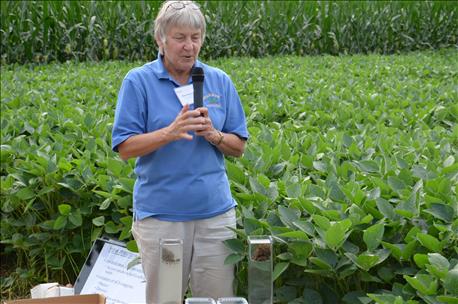
As far back as the 1980s, those who believed in conservation tillage began pushing for farmers to consider no-till vs. conventional tillage. As more farmers racked up several consecutive years in no-till, demonstrations showing the difference between no-till and conventionally tilled soils began to show up with regularity at field days.
The classic demonstration to prove the point goes like this: Collect samples of soil from a conventionally tilled field and a no-till field and show them to the audience at a field day. Then drop each one in a beaker or large glass cylinder full of water.

NEXT STEP AFTER NO-TILL: Ten years ago you might have seen someone do this demonstration with no-till and conventional soils. Now Purdue’s Eileen Kladivko does with it with all no-till soil; the difference is cover crops (right) vs. no cover crops (left).
The conventional soil quickly breaks apart and dissolves. Sediment slowly builds up at the bottom of the beaker as particles of soil settle out.
The no-till soil floats for a much longer period of time in its beaker. A portion of it breaks off and settles out, but the total amount is much less than the amount that falls off of the clump of conventional soil.
It’s hard to watch that demonstration and not become a believer in the ability of no-till to alter soil behavior. If soil isn’t breaking apart and settling to the bottom, the translation is that it has more structure, and it’s absorbing water instead. The implication is that water will infiltrate into the soil more quickly in no-till fields. Most farmers who’ve no-tilled for a long time agree that’s true.
Next step
Go to a conservation field day today and you may see a similar demonstration. There will likely be two glass containers of water and two samples of soil. But there might be a twist.
Eileen Kladivko, Purdue University Extension agronomist, performed the experiment for visitors at Purdue’s first-ever Corn Showcase at the Agronomy Center for Research and Education this summer.
Only it wasn’t no-till soil and conventional soil that she pitted against each other. Both soil samples were from no-till fields. The difference was that one sample was from a no-till field where no cover crops were grown. The other was from a field where cover crops grew until it was time to plant the new crop.
The results are relatively similar to the original version of this demo. The no-till soil without cover crops holds together just as it did before, with some flaking off and settling out. But the no-till soil with cover crops barely flakes off at all. There is virtually no soil at the bottom of the cylinder. The soil remains intact just below the water line in the cylinder.
“No-till is good in protecting the soil and improving water infiltration over time, but no-till with cover crops is even better,” Kladivko says. “That’s what we’re trying to show. If we still included a conventional clump of soil in a third column of water, it would dissolve relatively quickly, and much of it would wind up at the bottom of the cylinder, just like it did when people did this demo before."
The question today is not if no-till is better for soil health than conventional tillage, Kladivko says. It’s whether no-till plus cover crops improves soil health even more. She says the answer is yes.
“Substances almost like glue that form after cover crops help hold soil particles together tightly,” she says. “Very little soil dissolves.
“This is just one way that people can see that cover crops help improve soil health,” she concludes.
About the Author(s)
You May Also Like




